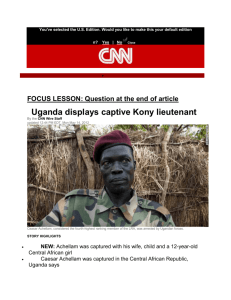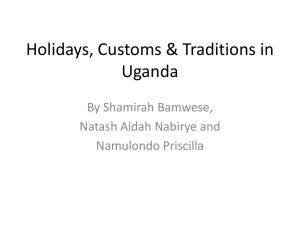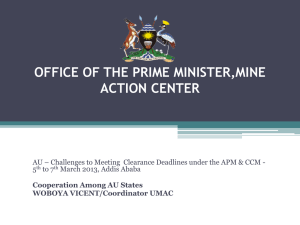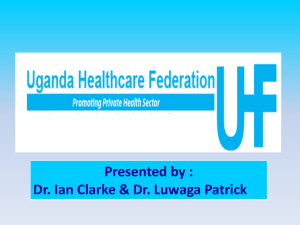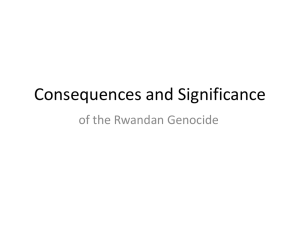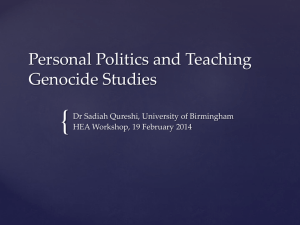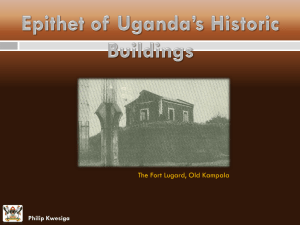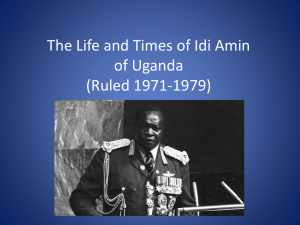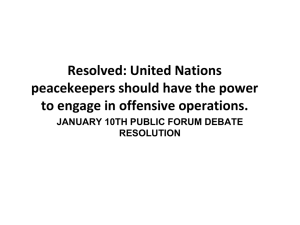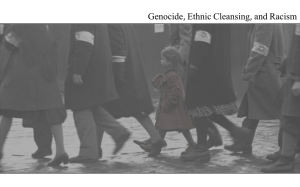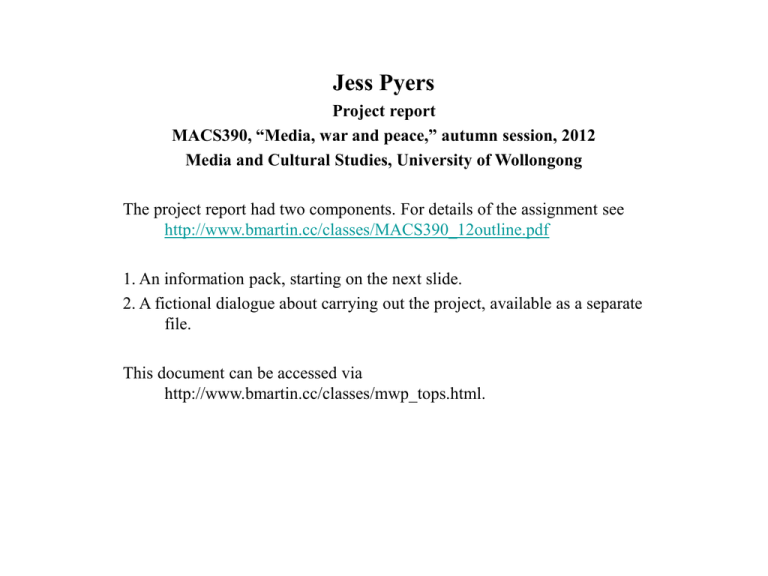
Jess Pyers
Project report
MACS390, “Media, war and peace,” autumn session, 2012
Media and Cultural Studies, University of Wollongong
The project report had two components. For details of the assignment see
http://www.bmartin.cc/classes/MACS390_12outline.pdf
1. An information pack, starting on the next slide.
2. A fictional dialogue about carrying out the project, available as a separate
file.
This document can be accessed via
http://www.bmartin.cc/classes/mwp_tops.html.
The Ugandan Genocide
Student number: 3877309
What is Genocide ?
The 1948 United Nations Convention on the Prevention and
Punishment of Genocide defines it as:
“any of the following acts committed with intent to destroy, in
whole or in part, a national, ethical, racial or religious group, as
such: Killing members of the group; Causing serious bodily or
mental harm to members of the group; Deliberately inflicting on
the group conditions of life calculated to bring about it’s physical
destruction in whole or in part; Imposing measures intended to
prevent births within the group; Forcibly transferring children of
the group to another group.” [1]
This is the accepted legal definition of genocide.
The Ugandan Genocide
• In Uganda, genocide has
gone on for years and years
without proper remedial
measures.
• It’s location and size
makes the country
insignificant to warrant
the attention of the
western world.
• There is the western idea of Africa being seen as a “lost cause,” so
why report? [2]
The history of Genocide in Uganda
• The genocide began in 1962, when Uganda gained independence
from Britain. The Ugandan people became victims to acts of
genocidal massacre, as those with political power directed
massacres against certain ethnic and social groups.
• Between 1966 and 1971, Milton Obote’s regime targeted the
Baganda people, and about 1,000 people were reported to have
been killed. [3]
• In 1971, the dictator Idi Amin, seized control of the country and
caused much violence and bloodshed. Amin targeted the Acholi and
Langi people, particularly those in the armed forces, and thousands
of people were killed. [4]
• In 1980, Tanzania led a war to overthrow Amin, and Obote
returned to power. He, again, targeted the Baganda people for
killings. More than 300,000 people were killed. [6]
• In 1986, Yoweri Museveni, an ethnic Munyankole from southwestern Uganda, captured power, and has held it ever since.
From 1986 to 2003, the Acholi people in northern Uganda have
been indiscriminately targeted and terrorised. [7]
• Even though Amin’s regime killed the Acholi political leaders,
business community and military officers, Museveni’s campaign
has turned out to be many more times devastating for Uganda.
A theory of Genocide
• According to Bradley Campbell, genocide is a method of social
control. His theory suggests that genocide “belongs to a part of social
life that incorporates law and gossip, aspects of society that are used
to control and manipulate”. [8]
• Cultural distance must be present between the groups involved and
society should be organised along “ethnic lines, where there is a
higher degree of ethnic visibility”. [9] This creates unequal statuses
between the groups, causing them to fight each other in order to
preserve society.
• This theory can be applied to the Ugandan Genocide, as an
important part of the context for the conflict is the major ethnic fault
line that runs though Uganda along with the Nile river. There is no
trust between the Nilotic people of the northeast (including the
Acholi) and the Bantu-speaking people of the southwest.
• The international community is blind to the genocide occurring in
northern Uganda, due to the lack of coverage and ignorance of the
conflict.
What isn’t covered in media portrayals of the Ugandan
Genocide
• To keep the eyes of the world averted, Museveni and his
government have carefully scripted a narrative in which terror
occurring in northern Uganda begins with the Lord’s Resistance
Army (LRA) and will only end with their demise. [10]
• Under Museveni’s regime, entire Acholi villages have been
destroyed, as legitimate and proper action against the rebels
(LRA). Crops in the so-called “war zones” have been uprooted
allegedly to deny the food to the LRA.
• Museveni is using the cover of war to move an entire society,
the Acholi people, to overcrowded “protection”camps where they
face disease, and even death.
The truth about the “protection camps”
• The media has correctly presented the many atrocities committed by the
murderous LRA, but has continuously portrayed Museveni, as someone who has
brought stability to the conflict in Northern Uganda. This is not true. The media
neglects to address the role of Museveni and the Ugandan Army in perpetuating
the genocide. This is what you do not know:
• Approximately 1.5 million people, who live in the camps, were forcibly
removed from their homes by the government when it was unable to beat the
LRA. Those who refused to leave were subjected to beatings or random shellings
of their village. [11]
• The Ugandan Army has failed to provide security for the Acholi people from
LRA attacks at the “protection” camps.
• The female inmates are at the mercy of the National Resistance Army (NRA),
the soldiery of the Museveni regime, who abuse and rape them. [12]
• Soldiers that are known to be infected with contagious diseases, including the
deadly HIV, are posted to the camps with the mission of wrecking maximum
havoc on the female inmates.[13]
High Altitude photo of northern Uganda’s “protection”
camps
• Each of the dots is presumably a house for a family.
The Lord’s Resistance Army (LRA) & Genocide
• For the past 20 years, the leader of the LRA, Joseph Kony has been fighting to
establish a Christian 10 commandments based theocracy in northern Uganda.
• It is a militant group with only 200 core members.
• The LRA’s favoured mode of operation is to abduct and brainwash Acholi children
into becoming child soldiers and sex slaves.
• In gruesome initiation rites, Kony forces the children to mutilate and kill their own
family and friends. [15]
• Since 1987, Kony is believed to have recruited more than 24,000 child soldiers and
displaced around 2 million people. [16]
• To escape abduction, torture and murder, thousands of children flee their rural
villages each night to sleep in larger towns where they are safer. These are northern
Uganda’s ‘invisible children’. [17]
• What is puzzling about the LRA is that while it claims to be fighting on behalf of
the Achole people against the government, most of it’s attacks have been carried out
against the Acholi people.
Northern Uganda’s night commuters
Harrowing images, like this one, have seeped into international media,
but that is where the awareness ends, and that’s just how the Ugandan
government wants it.
The Secret Genocide
• The misreporting of the Ugandan Genocide has allowed it to continue
without international intervention for longer than it should.
• The official line from the Ugandan Government that is obediently recited
around the world is that” the killing fields of northern Uganda are strictly
the result of the rebel activities by the LRA”. [18]
• The government perpetuates the war, uses the LRA as an excuse to
mobilise international support and military supplies, and fails to defeat the
LRA or provide for the people in any way. [19]
• What is appalling, is that Ugandans south of the river Nile, apparently do
not know that these disturbing events are taking place in northern Uganda.
“At least Amin killed only our educated sons and parents, but Museveni and
his accomplice (LRA leader, Joseph Kony), are determined to wipe out a
whole people,” said a mother in a “protection” camp to a human rights
worker. [20]
Worldwide awareness of the Ugandan Genocide
• The unimaginable atrocities, and human suffering that the LRA
has inflicted on thousands of innocent northern Ugandans,
received worldwide attention on March 5th 2012.
• On March 5th, Jason Russell, the co-founder of an activist group
called ‘Invisible Children’, posted a video on Youtube and Vimeo
titled ‘Kony 2012’. The video attracted more than 50 million
viewers and generated hundreds of thousands of dollars in
donations on the first day. [21]
• The “Kony 2012” campaign was successful at pressuring the
United States Government to deploy soldiers in Uganda to assist
the Ugandan army with capturing Kony.
-“Kony 2012” video link: http://www.youtube.com/watch?v=Y4MnpzG5Sqc
Image 1
Image 2
However, the “Kony 2012” video did not report
accurately and fairly on the Ugandan Genocide..
• The film failed to mention the human rights abuses by the Ugandan
military.
• It implied that there are as many as 30,000 child soldiers in Kony’s army
today. After years on the run, the group is believed to be down to hundreds
of fighters.
• It is not until halfway through the film that the audience find out “the war”
described is no longer happening in Uganda. The LRA left Uganda years
ago and moved to more fragile countries, like the Democratic Republic of
Congo.
• The fact that the international media uses the term ‘war’ instead of
‘genocide’ to describe the horrific events occuring in northern Uganda
highlights the world’s ignorance, and unwillingness to accept the conflict as
a genocide.
Responses to the “Kony 2012” campaign
• Critics accused the ‘Invisible Children’ organisation of spending millions
of dollars on officer salaries, filmmaking costs and travel, as opposed to
on-the-ground programs to help rebuild the lives of the people traumatised
by the conflict. [22]
• “Kony 2012” was accused of promoting ‘slacktivism,’ which is the idea
that sharing, liking or retweeting will solve the problem across social
media. [23]
• This may be why the organisation’s second campaign, ‘Cover the Night,’
was unsuccessful, since it required effort- people had to leave the safety of
their computers and be activists in their community.
• Northern Ugandans, who watched the film, supported the film’s message
of stopping Kony. However, they took offence at how the message was
delivered from a western perspective instead of a Ugandan perspective.
‘Invisible Children Uganda’
• ‘Invisible Children Uganda’ has improved the quality of life
for some war-affected people in Northern Uganda.
• The organisation has helped built schools and provided the
Ugandans with access to quality education.
• It has helped local leaders build LRA warning devices,
which inform the community when the rebel groups are near.
• The organisation has also helped the leaders design and
implement sustainable development programs that will have a
positive impact on the community.
The Ugandan Genocide must end !
• Firstly, the international community must demand the
dismantling of all of the “protection” camps in northern Uganda,
and institute an organised program of resettlement.
• Humanitarianism must be smart. The LRA is frightening, but
northern Ugandan people have more to fear from their own
government. It’s time the world understood that. The
humanitarian catastrophe in northern Uganda is a bigger story
than the LRA. It is ultimately about “the failure of the United
Nations and the western powers, to hold the government of
Uganda accountable.” [24]
References
• Abote. A.M, 1990, ‘Notes on Concealment of Genocide in Uganda’,
Uganda People’s Congress, available from
http://www.upcparty.net/obote/genocide.htm, accessed on 30/05/12
• Boston. D, 2012, ‘Genocide in Uganda: The African Nightmare
Christopher Hitchens missed,’ The Huffington Post, available from
http://www.huffingtonpost.com/daniella-boston/genocide-in-ugandathe-af_b_21150.html, accessed on 2/06/12.
• Campbell, C., 2009, ‘Genocide as Social Control,’ Sociological
Theory, vol 27, no. 2, pp150-168.
• Chodos. B, 2008, ‘Northern Uganda- The human face of atrocity,’
Inroads, vol.23, pp.117-129.
• Convention on the Prevention and Punishment of the Crime of
Genocide, Adopted by the General Assembly of the United Nation on
9 December 1948, available from
http://untreaty.un.org/English/millennium/law/human_rights/iv_1E.w
pd, accessed 30/05/12.
• Craine. A, 2012, ‘Joseph Kony’, Encyclopaedia Britannica Online, available from
http://www.britannica.com.ezproxy.ow.edu.au/Ebchecked/topic/1017670/JosephKony, accessed on 2/06/12.
• Fox. Z, 2012, ‘Kony 2012: Is the Viral Campaign a Scam?’, Mashable US and
World, available from http://mashable.com/2012/03/08/kony-2012-scam/, accessed
on 30/05/12.
• Kawalya. A.B, 2012, ‘Uganda’, eNotes, available from http://enotes.com/ugandareference/uganda, accessed on 30/05/2012.
• Otunnu. O, 2006, ‘The Secret Genocide’, Foreign Policy, vol.155, pp.44-46.
• New York Times, 2012, ‘Lord’s Resistance Army’, available from
http://topics.nytimes.com/top/reference/timestopics/organizations/l/lords_resistance
_army/index.html, accessed on 30/05/12
• Pearson. C, 2008, ‘LRA: The Genocide We Missed’, a Nadder, available from
http://anadder.com/lra-the-genocide-we-missed, accessed on 31/05/12.
• Wegner. P, 2012, ‘A Genocide in Northern Uganda?- The ‘Protected Camps’
Policy of 1999 to 2006’, Justice in Conflict, available from
http://justiceinconflict.org/2012/04/09/a-genocide-in-northern-uganda-theprotected-camps-policy-of-1999-to-2006/, accessed on 1/06/12.
Image References
• Image 1-http://thecable.foreignpolicy.com/category/region/africa
•
Image 2- http://www.kstensaasfamily.com/images/uganda_map_detail_gif
• Image 3- http://uganda.blogspirit.com/archive/2010/01/22/african.genocide.html
• Image 4- http://www.exposeugandasgenocide.blogspot.com.au/
• Image 5- http://exposeugandasgenocide.blogspot.com.au/2007/11/satellite-photosof-ugandas-death-camps.html
• Image 6- http://glogster.com/helenarcotic/uganda-genocide/g60qocilfbfkfftrm053ev6r
• Image 7- http://pathwayplans.blogspot.com.au/
• Image 8- http://uganda.blogspirit.com/archive/2008/05/08/uganda-yowerimuseveni-the-genocide.html
• Image 9- http://afripopmag.com/2012/03/african-reactions-to-the-kony-2012campaign
• Image 10- http://www.revousa.org/kony-2012-gunns-gold-imperialism

